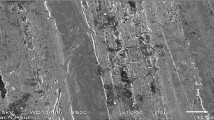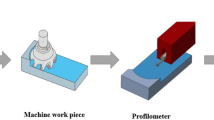Abstract
Product manufacturing on CNC milling machine tools involves a number of machining parameters and tool geometries. In the case of sculptured or free-form surfaces the number of these parameters can be significantly large and vary according to surface complexity. Minimising the number of parameters is carried out through statistical elimination. Design of experiments (DoE) along with the respective statistical analysis of variance (ANOVA) constitutes a low-cost useful tool in determining sub-optimum values for all parameters involved in each milling strategy as well as the most significant of those parameters. DoE was implemented for a particular sculptured surface assessing a variety of roughing and finishing strategies of a CAM simulation software.
Similar content being viewed by others
References
Dong Z, Li H, Vickers GW (1993) Optimal rough machining of sculptured parts on a CNC milling machine. J Eng Ind 115:424–431
Chuang SH, Pan CC (1998) Rough cut tool path planning for B-spline surfaces using convex hull boxes. Int J Adv Manuf Technol 14(2):85–92
Hu YN, Tse WC (1998) Tool path planning for rough machining of a cavity by layer-shape analysis. Int J Adv Manuf Technol 14(5):321–329
Jensen CG, Anderson DC (1996) A review of numerically controlled methods for finish-sculptured-surface machining. IIE Trans 28(1):30–39
Lauwers B, Kruth JP, Dejonghe P (2000) An operation planning system for multi-axis milling of sculptured surfaces. Int J Adv Manuf Technol 17(11):799–804
Vafaeesefat A, ElMaraghy HA (2000) Optimal workpiece orientations for machining of sculptured surfaces. Proc Inst Mech Eng B 214(B8):671–681
Chiou CJ, Lee YS (2002) A machining potential field approach to tool path generation for multi-axis sculptured surface machining. Comput Aided Des 34(5):357–371
Tournier C, Duc E (2002) A surface based approach for constant scallop height tool-path generation. Int J Adv Manuf Technol 19(5):318–324
Lim EEM, Menq CH (1997) Integrated planning for precision machining of complex surfaces, part 1: cutting-path and feedrate optimization. Int J Mach Tools Manuf 37(1):61–75
Baptista R, Antune Simoes JF (2000) Three and five axes milling of sculptured surfaces. J Mater Process Technol 103:398–403
Tandon V, El-Mounayri H, Kishawy H (2002) NC end milling optimization using evolutionary computation. Int J Adv Manuf Technol 42:595–605
Lin TR (2002) Optimization technique for face milling stainless steel with multiple performance characteristics. Int J Adv Manuf Technol 19:330–335
Lin JC, Tai CC (1999) Accuracy optimization for mould surface profile milling. Int J Adv Manuf Technol 15:15–25
Chen YH, Lee YS, Fang SC (1998) Optimal cutter selection and machining plane determination for process planning and NC machining of complex surfaces. J Manuf Syst 17(5):371–388
Ross PJ (1996) Taguchi techniques for quality engineering. McGraw-Hill, New York
Author information
Authors and Affiliations
Corresponding author
Rights and permissions
About this article
Cite this article
Krimpenis, A., Fousekis, A. & Vosniakos, G. Assessment of sculptured surface milling strategies using design of experiments. Int J Adv Manuf Technol 25, 444–453 (2005). https://doi.org/10.1007/s00170-003-1881-x
Received:
Accepted:
Published:
Issue Date:
DOI: https://doi.org/10.1007/s00170-003-1881-x




